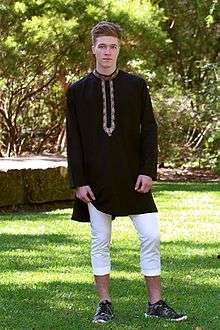Indo-Western clothing
Indo-Western clothing is the fusion of Western and South Asian fashion.[1]
History
In the 1960s and 1970s, at the same time as Western fashion was appropriating elements of Indian dress, Indian fashion also absorbed elements of Western dress.[2][3] This practice of mutual appropriation continued throughout the 1980s and 1990s, as multiculturalism in fashion design took hold, with Western designers incorporating traditional Indian crafts, textiles and techniques at the same time as Indian designers allowed the West to influence their work.[2] While middle-class Indian women in migrant communities originally tended to favour Western styles for all occasions in the 1960s and 1970s, they gradually began to wear stylish Indian dress for special occasions as a status symbol equivalent to chic Western fashion.[4] One example of a traditionally Indian garment that has been heavily influenced by Western fashion is the kurta suit, a reversal of the established tradition of Western fashion being influenced by Asian design.[3] Geczy noted that, ironically, an Indian woman wearing traditional clothing might find herself said to be "imitating" Western fashion, and that the boundaries between East and West in fashion were becoming increasingly blurred.[3]

21st century
By the first decade of the 21st century, Western styles were well established as part of Indian fashion, with some professional Indian women favouring Western-style dresses over saris for office wear.[4] Fashionable Indian women might take the traditional shalwar kameez and wear the kameez (tunic) with jeans, or the pants with a Western blouse.[4]
Among the youth, there appears to be an enthusiastic approach to combining traditional clothes with a western touch.[5] With increasing exposure of the Indian subcontinent to the Western world, the merging of women's clothing styles is inevitable. Many Indian and Pakistani women residing in the West still prefer to wear traditional salwar kameez and sarees; however, some women, particularly those of the younger generation, choose Indo-Western clothing.
The clothing of the quintessential Indo-Western ensemble is the trouser suit, which is a short kurta with straight pants and a dupatta. Newer designs often feature sleeveless tops, short dupattas, and pants with slits. New fusion fashions are emerging rapidly, as designers compete to produce designs in tune with current trends.
Additional examples of the fusion that Indo-Western clothing represents include wearing jeans with a choli, salwar or kurta, adding a dupatta to a Western-style outfit, and wearing a lehnga (long skirt) with a tank top or halter top. For men Indian traditional Kurta with sports shoes and scarves.
Distinctive elements in Indo-Western fashions

- Sleeve length - The traditional salwar has long or short sleeves. An Indo-Western design might forego sleeves altogether, or replace the sleeves with spaghetti straps, resembling the style of a tank top or halter. There are also poncho-styled tops and one-sleeve designs that follow contemporary Western trends.
- Shirt length - Indo-Western kurtas and salwars tend to be much shorter than those traditionally worn, so that they resemble Western-style blouses.
- Necklines - Some Indo-Western tops are available with plunging necklines, in contrast to the traditional styling of salwars and kurtas.
Well known wearers of Indo-Western fashion
A few who are well known enthusiasts of the hybrid fashion are Indian actress Shilpa Shetty,[5] English actress Dame Judy Dench and Bollywood actress Sonam Kapoor
See also
- Fashion in India
- 1945-1960 in Indian fashion
- 1960s in Indian fashion
- 1970s in Asian fashion
- 1990s in Indian fashion
- 2000s in Indian fashion
- 2010s in Indian fashion
References
- ↑ Comparative Study of Historical Women clothing In North of India and North of Iran Literature Review
- 1 2 Craik, Jennifer (2003). The Face of Fashion: Cultural Studies in Fashion. Routledge. p. 38. ISBN 1134940564.
- 1 2 3 Geczy, Adam (2013). "Postwar Revivalism and Transorientalism". Fashion and orientalism : dress, textiles and culture from the 17th to the 21st century. London: Bloomsbury. p. 185. ISBN 9781847885999.
- 1 2 3 Lakha, Salim (2005). "The state globalisation and Indian middleclass identity". In Pinches, Michael. Culture and Privilege in Capitalist Asia. Routledge. pp. 252–277. ISBN 9781134642151.
- 1 2 Bollywood Vogue July 8, 2014 Indo-Fusion Look and Bollywood Prapti Bagga Arora
Further reading
- Sandhu, Arti (2014). Indian Fashion: Tradition, Innovation, Style. Bloomsbury. ISBN 9781472590855.
- Devs Costumes. "Bollywood Style Sheet"